Unmeelan
An exhibition of
Glimpses of Kashmiri Pandit Cultural Heritage
12th-14th April 1998
Organized by:
N.S. Kashmir Research Institute
D-7/7175, Vasant Kunj, New Delhi - 110 070 (India)
Glimpses of Kashmiri Pandit Cultural Heritage
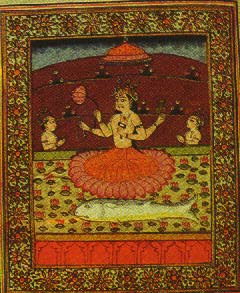
>>> Click
here for an Introductory Address <<<
The word 'Unmeelan' means
'opening of the eyes'. And this exhibition is an invitation to opening
of eyes, if only to have glimpses of the heritage and traditions of a people
who have contributed most significantly to Indian culture, literature,
philosophy, art and aesthetics. The Kashmiri Pandits. It is tragic that
they have been uprooted from their native soil and are struggling desperately
today to stave off the threat of cultural extinction looming sinisterly
over them.
This exhibition seeks to capture aspects of their
fascinating cultural life even as they find the world around them crumbling.
It is an attempt to put together fragments of their shattered world and
project a picture of the brilliance with which it once glowed.
One ot the earliest extant accounts of the ideas
and values that shaped the Kashmiri mind is the Nilmata Purana, a 6th century
text which gives Kashmir's own creation myth. It shows Kashmir not just
as a geographical denomination but as a repository of concepts and creativity,
a cradle of Indian civilization; its people living in perfect harmony with
their natural environs whose enrapturing beauty they often excelled in
thought and spirit. By the time Kalhana composed his immortal work, the
Rajatarangini, the Pandits of Kashmir had already acquired repute as a
peaople for whom learning was almost as important as breathing. "It is
the land of learning", says Kalhana effusively, "of high dwellings, saffron,
ice-water and grapes". Bilhana, the renowned author of 'Vikramankdevacharita',
describes Kashmir, his native place, as a land where even the hoi polloi
indulge in the pleasure of poetry.
Right from the very ancient times, the Kashmiri
mind gravitated towards cerebral graces, setting into motion thinking processes
that set the tone for intellectual debate across the whole of India. For
centuries scholars were attracted to Kashmir for interaction and exchange
with its Pandits in fields as varied as religion, philosophy, literature,
logic, dance, drama, music, art, architecture and aesthetics.
It was during one such interaction and debate
held amidst the pine groves of Harwan that Mahaayana had its birth when
Kanishka called the fourth world Buddhist council there. Earlier Ashoka,
who founded Shrinagar, had gifted away the whole Kashmir valley to the
Buddhist Sangha. Mahaayana was indeed Kashmir' s great gift to Buddhism,
and from there the doctrine was taken to Central Asia, China, Tibet, Japan
and as far as Indonesia by Kashmiri missionaries. If it was one Kashmiri
monk who introduced the concept of Lamaism in Tibet, another Kashmiri scholar
devised a script and grammar for the Tibetan language.
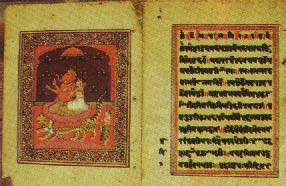
Yet another great contribution of the Pandits
of Kashmir to world thought is monistic Shaivism, a philosophy presenting
a vision of the world and man which is at once poetical. It does not hold
the phenomenal world as unreal but as the unfolding of the supreme reality
through its energy with itself as the screen. Shiva, according to this
philosophy, is unlimited consciousness, the essence and identity of everything;
and unrestricted freedom of will and action is the goal of human life.
The Shaiva philosophical movement, also known as Trika, swept the length
and breadth of the Valley from the 8th to the 14th century, providing a
philosophic framework for Lalleshwari's poetry and linking Kashmir with
centres of Shaivite thought in South India.
Along with Shaivism, the cult of Vishnu flourished
in Kashmir right from the time of Nilmata Purana, blossoming not only in
religion but in art and literature also. Kashmiri Vaishnavism had one distinguishing
feature - it synthesized the different Vaishnava cults prevailing in ancient
and medieval India.
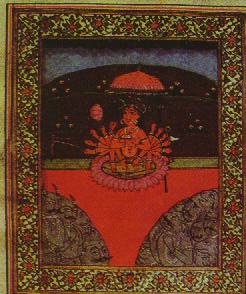
Shaktivada, or the cult of the Mother Goddess
has also deeply influenced the faith of the Kashmiri Hindus, particularly
in Her manifestations as Sharika, Ragya, Jwala and Sharada. It is Shakta
Tantrism that binds Kashmir, Bengal and Kerala in one common spritual bond.
The pan-Indian Bhakti movement too had a deep
impact in Kashmir resulting in the emergence of a distinct trend in Kashmiri
poetry.
Art and architecture in Kashmir took the shape
of a definite school which touched its highest peak towards the 7th and
8th centuries when kings like Lalitaditya and Avantivarman ushered in a
political and cultural renaissance. Architectural masterpieces of Hindu
Kashmir like the Sun temple of Martand and the Avantiswarnin temple are
products of this renaissance.
It was indeed a rich culture that percolated down
through various modes of expression from generation to generation in Kashmir
even after its Islamization. Kashmiri Pandits of today are proud inheritors
of this great heritage and have tried to cling to its essence and spirit
despite the horrors of past holocausts haunting their racial memory. Uprooted
and dispossessed, they find that much of what constituted their heritage
has been destroyed or damaged beyond repairs. Stunned by the loss they
still feel they are the true representatives of the mainstream of Kashmiri
culture. "Unmeelan" is an attempt to reconstruct a picture of their heritage,
however fragmentary, with whatever material that could be salvaged after
their tragic exodus from Kashmir. It could well be described as the profile
of a culture in exile.
The exhibition is broadly divided into three sections.
SECTION -1
Miniature Paintings of the Kashmiri School
For the first time ever rare and exquisite Kashmiri
miniatures are being displayed. The paintings, many of them original heirlooms
loaned to NSKRI, are important from the point of view of studying the basic
features of the Kashmir school, a systematic study of which is being undertaken
by the Institute. The earliest evidence of the development of this school
can be seen in the illuminations of the Gilgit manuscripts. The best examples
of the Kashmiri style are said to have existed during the rule of Lalitaditya
and Avantiverman bearing a close affinity to that of Kashmiri bronzes dated
to 9th to 11th century . It survived in wall paintings of Buddhist monastries
like Alchi in Ladakh and Mang Nang in Western Tibet. After Islamization
of Kashmir, many of its masters migrated to Himachal princedoms where it
revived as the Pahari- Kangra school. Most of the surviving paintings of
the Kashmir school belong to a period not earlier than the late 18th or
early 19th century. The N. S. Kashmir Research Institute proposes to bring
out a representative album of the Kashmir miniatures.
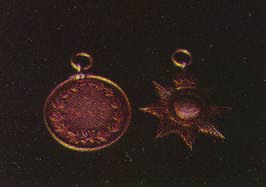
SECTION - 2
Manuscripts and Documents: A Saga of Scholarship
This section comprises of Sharada and Persian manuscripts
from Kashmir and documents related to Kashmiri Pandit scholarship represented
mainly by Pandit Nityanand Shastri. These include letters written to the
great Sanskrit scholar by well known Indologists like Aurel Stein, George
Grierson, J. Ph. Vogel, Sten Konow, Maurice Winternitz and others. These
letters throw interesting light on many an important aspect of cooperation
between European and Kashmiri Pandit scholars in understanding and reinterpreting
Kashmir's cultural past. Some documents related to Kashmiri Pandit history
have also been put on view. Portraits of some of the foremost Kashmiri
Pandit scholars and saints of the last century and the present one also
form a part of this section to show a glimpse of a unique scholastic tradition.
This will reveal how the words 'Kashmiri Pandit' and scholarship have remained
synonyms down to the present age.
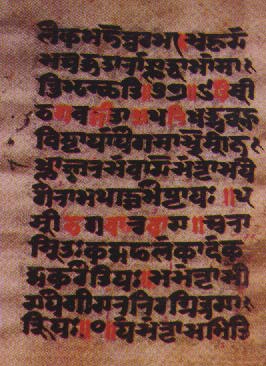
Sharada is the script which the Kashmiris devised
to write their sacred lore and literature. The script developed around
the 8th-9th century and spread to the neighbouring Himalayan regions. Unfortunately,
it is becoming obsolete now, more due to political than academic reasons.
This section of 'Unmeelan' will display some Sharada manuscripts as well
as Persian manuscripts from Kashmir. Scholars of the NSKRI plan to go on
an extensive tour in search of Sharada manuscripts.
SECTION - 3
Way of Life
Along with religion, literature and art, objects
related to day-to-day life and activities of a people can also be taken
as expressions of their culture. This section seeks to portray some aspects
of the traditional way of life of the Kashmiri Pandits with the help of
costumes, artifacts, articles of daily and ritualistic use and folk- art
patterns. While pheran still remains the traditional apparel of the Pandits,
men and women alike, and married women still wear the dejihor, many interesting
things which formed a part of their tradition are fast disappearing or
are in various stages of extinction. For instance, Gora tray, the painted
scroll depicting folk deities with an invocation to Saraswati which gladdened
the hearts of every Kashmiri Pandit child not many years ago, has already
disappeared from the scene. Among the other folk-arts that have vanished
are the decorative paintings or drawings known as the Krul Pachh that every
family used to receive on the Kashmiri Pandit New Year' s day. Some like
the Krul, or the auspicious door decorations are still surviving but only
as a crude manifestation of the original floral motifs. 'Vyug' - a circular
pattern drawn on the ground on which a bridegroom is made to stand before
marriage - is still there as a reminder of bhumishobha or the art of decorating
the ground with paintings, but 'Harmandul' - another such pattern drawn
at the peak of summer to worship the Sun - may have already vanished. Care
has been taken to include such basic elements of Kashmiri Pandit traditions.
Old photographs showing religious and social customs have also been put
on view.
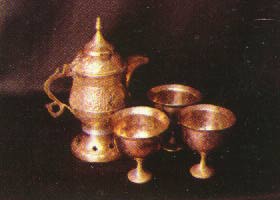
Acknowledgments
N. S. Kashmir Research Institute would like to thank
the following friends for their valuable cooperation and enthusiastic assistance
to make 'Unmeelan' a success:
S/Shri J.N. Pandita, Virendra Qazi,
M.L. Ticku, Dr. R.K. Ganjoo,
S.L. Razdan, Kamla Shanker,
B.L. Bhat, Dr. B.L. Kachroo, M.L. Dhar,
M.L. Kemu, Prof. O.N. Chrangoo,
S.K, Turki, A.K. Zadoo, Dr. H.L. Saraf,
Prof. K.K. Bhat, M.K. Zutshi,
R.K. Rawal,
Sabita Pandita, Rajendra Premi,
Shanta Bhat, Dr. C.N. Tickoo, D.P.
Bhan, Kishori Kaul, Utpal Kaul,
Arun Kaul, Bansi Lal Kaul,
G.L. Kaul Karwani,
Arun Jallali, Dr. Ajay Chrangoo,
Ram Krishen Jotshi, Dr. Ramesh
Tahmiri, Manohar Kaul, Keshav Malik,
Gauri Razdan Malik, Dr. B.N. Kalla,
Dr. C.L. Raina, Dr. Krishna Raina,
Kamlawati Raina, Avtar Raina,
Susheel Wattel, Amar Nath Razdan,
Dr. Ayushman Bhat, Dr. R. N. Bhat,
R.K. Raina, J.S Razdan,
B.L. Kaul Chaman, Prof. Krishna Misri,
Bharat Bhushan & S.K. Kotru
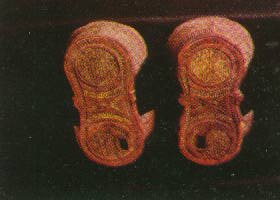
NSKRI Team
Concept, Design, Layout, Display, Research input
and Collection:
Dr. S.S. Toshkani, P.N. Kachroo, M.L. Pandit,
S.N. Pandita, Prof. B.L. Fotedar,
Prof. Subhash Razdan,Virendra Bangroo,
and C.V. Gopinath.
Our special thanks to:
Mr. Sunil Handoo for his artistic contribution.
Mrs. Mrinalini Bangroo for conservation work.
Mr. Ajmer Singh for fabrication support.
Mr. Rajeev Pandit for composing, artworks &
printing suport.
Financial Support:
A.K. Mandloo, Sabita Pandita, S.K. Pandita,
Veena Bhat, Prof. K.K. Bhat, T.N. Bhat,
S.N. Kaul Ghasi & A.N. Kaul
|
